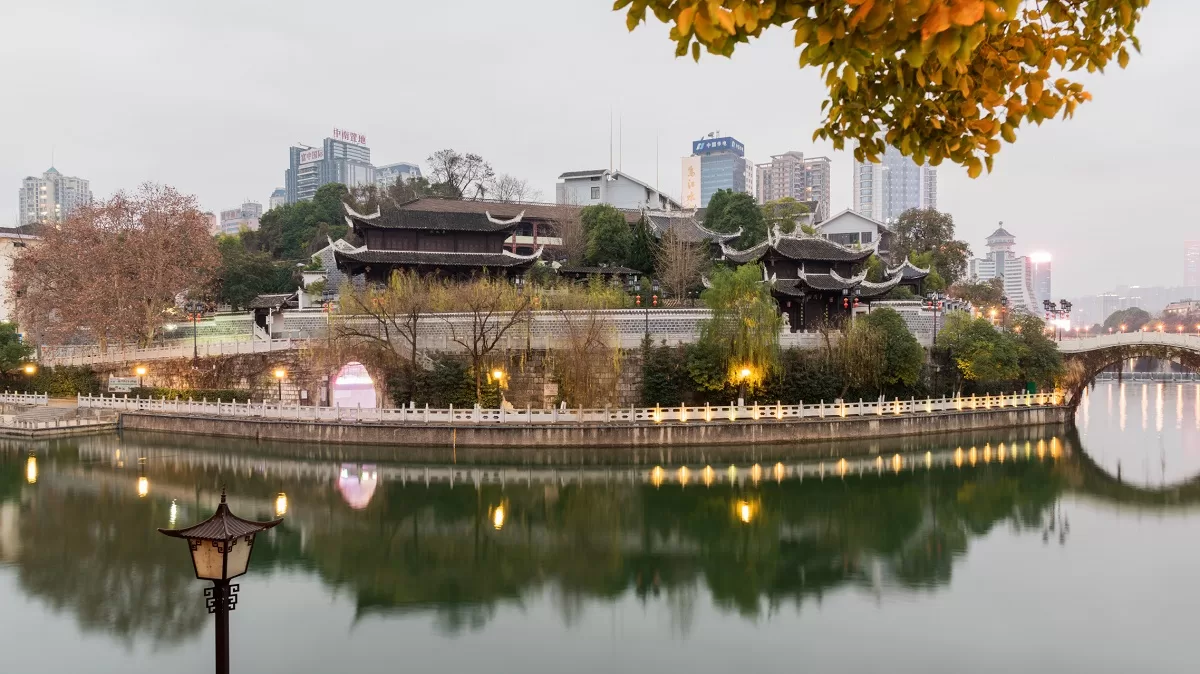Cuiwei Garden (翠微园), located in Guiyang, is a vast complex of ancient buildings adjacent to the Jiaxiu Pavilion in the southern part of the city. Covering an area of over 4,000 square meters, this historical site traces its roots back to the Ming Xuanzong era (1426-1435). The architectural ensemble within the garden showcases vibrant pavilions and galleries, surrounded by flower-adorned walls, creating a harmonious blend of tranquility, grandeur, and simplicity.
Basic Information
| Estimated Length of Tour | 1 – 2 hours |
| Ticket Price | 3 RMB |
| Opening Hours | 9.00 – 18.00; Last admission: 17.30 |
| Telephone Number | 0086-0851-85503811 |
Location and Transportation
Cuiwei Garden is situated on the southern bank of the Nanming River, located specifically at No. 8, Cuiwei Lane, in the Nanming District of Guiyang City. To get there, tourists can take bus 15, 34, 46, 48, 52, 61, 249, 264, or 307 and get off at Jiaxiulou Stop (甲秀楼站).
History of Cuiwei Garden
Originally known as Nan’an Temple, Cuiwei Garden was frequented by the renowned philosopher and educator Wang Yangming during his lectures at the Wenming Academy in the fourth year of the Ming Zhengde era (1509). Over time, the garden underwent name changes, evolving into Shengshou Temple during the middle and late periods of the Ming Zhengde era (1506-1521). It later transformed into the Wuhou Temple, dedicated to the worship of Zhuge Liang, an eminent figure in Chinese history, a practice that continued until the end of the Ming Dynasty.
In the twelfth year of the Qing Shunzhi era (1655), during the ninth year of the Southern Ming Yongli era, when the rebel leader Zhang Xianzhong stationed his forces in Guiyang, the Wuhou Temple was relocated and transformed into Guanyin Temple, dedicated to the Bodhisattva Avalokiteshvara. In the early years of the Daoguang era, a small three-bay building was added to the right of the temple, offering a scenic view of the water. In 1828, during the eighth year of the Daoguang era, Ruan Yuan, the Governor-General of Yunnan and Guizhou, inscribed the name “Cuiwei” on the temple, giving it the title of Cuiwei Pavilion. This iconic structure, situated along the Southern Ming River with a backdrop of hills and ancient trees casting shade, became a picturesque destination for sightseeing in Guiyang.
In the 29th year of the Republic of China (1940), Jiaxiu Elementary School was established within the temple premises, leading to the dismantling or repurposing of the mountain gate, main hall, and Cuiwei Pavilion. The bronze pagoda, dating back to the Ming Dynasty and housed within the pavilion, existed until the early stages of the Second Sino-Japanese War but eventually disappeared without a trace.
Starting from 1990, the municipal government initiated a comprehensive restoration project, reconstructing the Gongnan Pavilion, cultivating the “Danhua Kongcui” gardens, renovating the Cuiwei Pavilion, Longmen Academy, and extensively planting flowers, shrubs, and trees. Consequently, the site was officially named Cuiwei Garden, preserving its historical significance and transforming it into a cultural and scenic gem in Guiyang. Today, Cuiwei Garden stands as a testament to Guiyang’s rich history and cultural heritage, inviting visitors to explore its charming architecture and tranquil landscapes.










